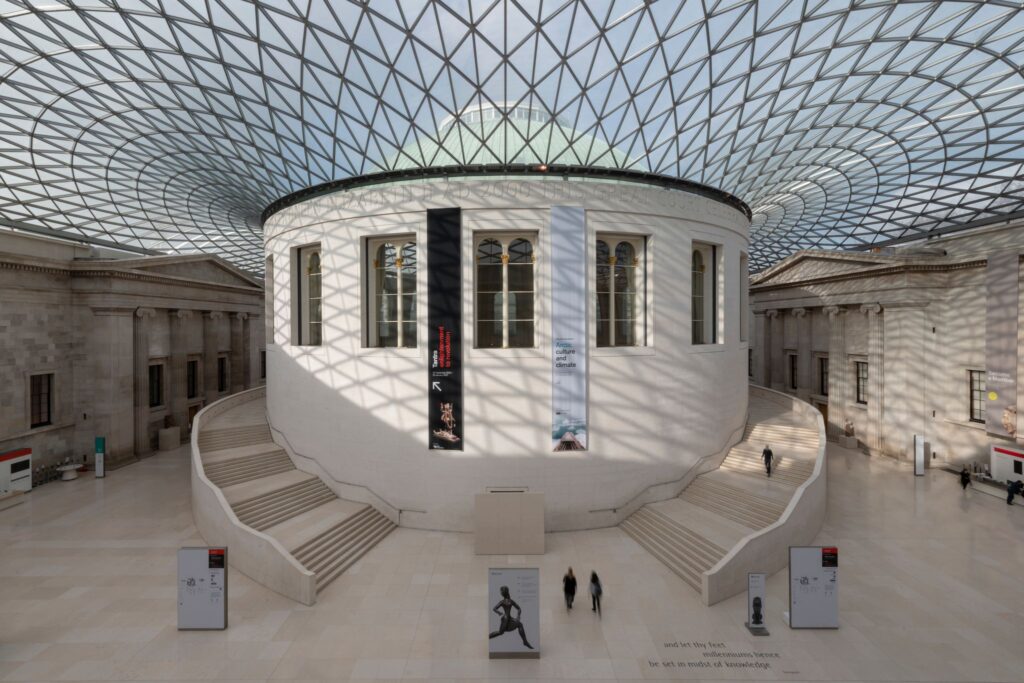The British Museum to reopen in time for Great Court’s 20th anniversary

The British Museum’s Great Court – one of the most recognizable museum interiors in the world – turns 20 on Sunday 6 December 2020. Due to the lifting of England’s national coronavirus restrictions and London entering Tier 2, the Museum will reopen ahead of the anniversary, welcoming the public again from this Thursday (3 Dec).
To celebrate the Great Court’s milestone, today the British Museum reveals that since it opened, 113 million people have now walked under the famous glass roof. The Museum also today releases brand new photos of the Great Court at 20, taken during England’s second lockdown.
The British Museum will welcome visitors again from this Thursday. Tickets are now available to book for acclaimed exhibitions Tantra: enlightenment to revolution and the Citi exhibition Arctic: culture and climate, along with free tickets to the permanent collection, where visitors can still see Grayson Perry’s installation The Tomb of the Unknown Craftsman and Edmund de Waal’s library of exile. https://www.britishmuseum.org/
Designed by Foster + Partners, the Queen Elizabeth II Great Court was opened by HM The Queen on 6 December 2000. At the opening ceremony, she hailed it as “a landmark of the new Millennium.”
Hartwig Fisher, Director of the British Museum, said: “I am delighted that the British Museum can reopen its doors in time for the 20th anniversary of the Great Court. This spectacular glass-roofed courtyard has welcomed 113 million people since the turn of the Millennium, and it is the glorious starting point for nearly every visitor. It is only fitting that this space, which transformed the visitor experience of this great institution, should be welcoming people once again on its 20th birthday.”
The Great Court is a two-acre space enclosed by a spectacular glass roof with the world-famous Reading Room in the centre. It is the most photographed space in the Museum on social media. Before it’s construction, the central space of the Museum was home to the British Library, including in the central Round Reading Room which was completed in 1857 and designed Sydney Smirke. The Library’s departure in 1997 was the catalyst for recapturing the courtyard as a new public space at the heart of the Museum. The £100m development was the final major Millennium Commission project to open in 2000. It was supported by grants of £30 million from the Millennium Commission and £15.75 million from the Heritage Lottery Fund.
Marking the 20th anniversary, Norman Foster, Founder and Executive Chairman, Foster + Partners, said: “The rediscovery of the amazing courtyard of the British Museum – the Great Court – and its rebirth as a new social focus followed what I have often called the historic tradition of change, which respects the past while steadfastly reflecting the spirit of its own time. The simple act of opening it up as the spatial heart of the museum was a catalyst in the Museum’s reinvigoration. The celebration of its 20th anniversary this year is a reflection of its success and we join in congratulating the British Museum for its foresight and vision.”
Spencer de Grey, Head of Design, Foster + Partners, said, “The opening of the Great Court symbolised the positivity and excitement about the future that characterised the new Millennium. As a public space, it gave the Museum a new, much needed vibrant heart, opening up a new public route through the building. Every time I visit the Museum, I’m heartened to see the many diverse groups enjoying its naturally lit environs and its magnificent neo-classical architecture, just as so many others have over the past twenty years.”
When opening the Great Court at a ceremony in 2000, HM The Queen said: “In the life of the nation, the British Museum is a remarkable phenomenon. It is an institution which has had a worldwide reputation for nearly 250 years and it is an enduring source of learning, inspiration and pleasure for millions of people who visit every year from this country and from overseas.
She added: “The Great Court will benefit the millions of people who come to the British Museum every year. We can be confident that it will become a landmark associated with the new millennium.”
To celebrate 20 years of the Great Court, the Museum here reveals 20 little known facts about the space;
1. In the original Robert Smirke design for the Museum, the central space within the quadrangle of buildings was supposed to be a garden and an open courtyard for promenading. However, from 1852 lots of bookstacks were built in the space, and along with the Round Reading Room it became the home of the library department.
2. The library which was homed in the courtyard was formally separated into a new body – the British Library – in 1972. It wasn’t until 1997 when it moved to a new home at St Pancras. The Library’s move facilitated the Great Court development.
3. It takes about two weeks to clean the whole roof. It gets cleaned every three months because being in the centre of London, it gets very dirty. Cleaners can’t walk unaided on the roof – instead they have to be hooked on by a harness to a network of cables that run over the roof, which can’t be seen from below.
4. The current design is not the first at the Museum to have proposed using a glass roof. In the early 1850s, Charles Barry, joint architect of the Palace of Westminster, proposed roofing over the courtyard with sheets of glass supported on 50 iron pillars. Inspired by the famous Crystal Palace of 1851, it was to have served as a Hall of Antiquities, but never came to fruition.
5. The roof is made up of 3,312 individual panels of glass, and no two panels are the same shape. They are held together by four miles of steel and there’s enough glass up there to glaze around 500 household greenhouses.
6. The roof stands 26.3 metres above the floor at its highest point – that’s nearly as tall as six of London’s famous double-decker buses
7. At two acres, it’s the largest covered square in Europe
8. The 315 tonnes of glass that make up the roof are supported by a 478-tonne steel structure – in total, that’s equivalent to seven-and-a-half blue whales
9. During construction of the new space, 20,000 m3 of demolition material was removed from inside the courtyard, equivalent to twice the volume of the Egyptian Sculpture Gallery or twelve Olympic swimming pools.
10. On completion, the redesign grew the Museum floor space by 40%. For the first time in more than 150 years, the new two-acre Great Court gave visitors the chance to move freely around the main floor of the Museum.
11. The Great Court can also get dark when the roof is covered in snow, so floodlights are fixed around the top of the Round Reading Room, illuminating the space.
12. The cafés in the Great Court serve over 1 million hot drinks each year
13. Famous guests to the Great Court include HRH The Prince of Wales, Nelson Mandela, Sir David Attenborough, President George W Bush, Angelina Jolie and Katy Perry.
14. In 2004 Great Court hosted a special display of costumes from the Wolfgang Petersen epic film Troy. These included the armour worn by Brad Pitt as Achilles, one of Helen of Troy’s gowns – played by Diane Kruger, and costumes worn by Eric Bana as Hector, Peter O’Toole as Priam and Brian Cox as Agamemnon. The film went on to be nominated for an Academy Award for Best Costume Design.
15. When The Queen opened the Great Court in 2000, our Visitor Services staff had the chance to put on the Windsor Livery, which can be worn on special occasions. It was granted to the Museum by King William IV in 1835, and consists of a blue coat with a scarlet collar and cuffs
16. Engraved into the floor is an extract from ‘The Two Voices’ by Alfred, Lord Tennyson. It says “and let thy feet, millenniums hence, be set in midst of knowledge”
17. The £100 million project was supported by grants of £30 million from the Millennium Commission and £15.75 million from the Heritage Lottery Fund.
18. The after-party of the world premiere of the James Bond film Spectre was held in the Great Court, with a Day of the Dead theme. All the stars including Daniel Craig attended.
19. In 2008, the Olympic Torch passed through the Great Court as part of its world tour from Olympia in Greece to the Olympic Games in Beijing, China.
20. The space has been the home of numerous installations over the last 20 years, including the Tree of Life in 2005, built from decommissioned firearms from the Mozambican civil war, by artists Kester, Hilario Nhatugueja, Fiel dos Santos and Adelino Serafim Maté.
Other installations have included a scale model of the ancient site of Olympia in 2004, a Volkswagen Beetle in 2014, Zak Ové’s Moko Jumbie figures in 2015, and Esther Mahlangu’s BMW Art Car 12 in 2016.




